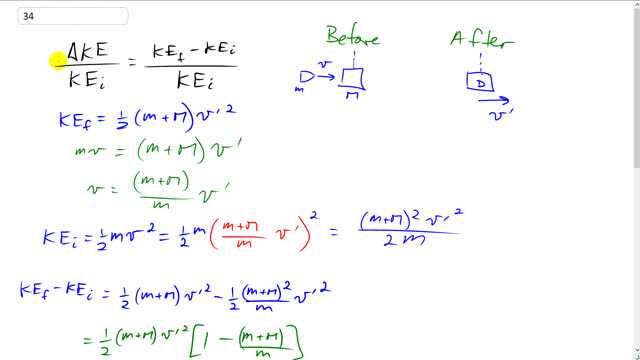
- Derive a formula for the fraction of kinetic energy lost, , in terms of and for the ballistic pendulum collision of Example 7–9.
- Evaluate for and .

In order to watch this solution you need to have a subscription.
This is Giancoli Answers with Mr. Dychko. Because the collision between this bullet and this pendulum is inelastic that means kinetic energy is not conserved so that's why it can ask in number 34 here what fraction of kinetic energy is lost? So we'll find the total kinetic energy of the system after the bullet is embedded within the pendulum minus the total kinetic energy of the system before and divide that by the kinetic energy before. So the kinetic energy before is just the kinetic energy of this bullet because the pendulum itself is not moving. So the kinetic energy after the bullet is embedded is going to be one-half times the total mass— bullet plus pendulum—times v prime which is the speed that the two move off together after the bullet is embedded and this is just immediately after the bullet is embedded before there's any increase in height, I mean eventually the speed is gonna reach zero when it gets to its maximum height but this speed is this speed that it has just after the bullet is finished embedding and before the pendulum has actually moved at all, I mean we assume it hasn't moved at all. So there's the kinetic energy final, kinetic energy initial we need to know how this speed v prime connects with the initial speed of the bullet. So initially the kinetic energy of the system is one-half bullet's mass times the bullet's speed before collision squared and we know that since momentum is conserved, we can connect the speed of the bullet before collision with the speed of the combined bullet and pendulum after collision, v prime. And we know that the total momentum initially is just that of the bullet m times v and the total momentum after collision is m plus M— bullet mass plus pendulum mass— multiplied by their combined speed, v prime and then solve that for the bullet's speed by dividing both sides by m. And then we substitute for that here in our initial kinetic energy formula; we write m plus M over m times v prime in place of v. And after squaring that, we end up with m to the power of 1 in the bottom even though it's little m squared in the bottom multiplied by this m makes m to the power of 1 and so we have m plus M squared times v prime squared over 2m so that gives us initial kinetic energy. So we are figuring out this numerator here and we are gonna go kinetic energy final minus kinetic energy initial and that's gonna be one-half sum of the masses times v prime squared minus one-half m plus M squared over m times v prime squared. So I'm substituting this here for kinetic energy final and I'm substituting this here for kinetic energy initial. And these two terms have a common factor— one-half m plus M v prime squared— well, that is the entire first time and so it becomes the number 1 minus what's left over in the second term after factoring that out— m plus M over m— and we can make a common denominator between this term and this term by multiplying the 1 by m over m and that makes m minus m minus M after you distribute this negative into or this minus into the brackets there all over m and the small m disappears there and we are left with one-half m plus M v prime squared times negative M over m and you end up with this line, okay. So that's the difference in kinetic energies and then you have to divide that by the initial kinetic energy which is better written as multiplying by its reciprocal. So we have this copied here and then multiplied by the reciprocal of the initial kinetic energy here so that's 2m over m plus M squared times v prime squared and so a whole bunch of common factors here; the v prime squared cancels and we have m plus M canceling with one of those so we have that to the power of 1 in the bottom, the 2m's cancel and we have negative M over m plus M. So the fraction of kinetic energy lost the negative sign says that the change in kinetic energy is a loss, not a gain and so we have mass of the pendulum divided by the mass of the bullet plus the mass of the pendulum. And in part (b), we have to do calculation with some example masses. So we have 380 grams of the pendulum divided by 18 grams of the bullet plus 380 grams gives 95 percent of the kinetic energy is lost.